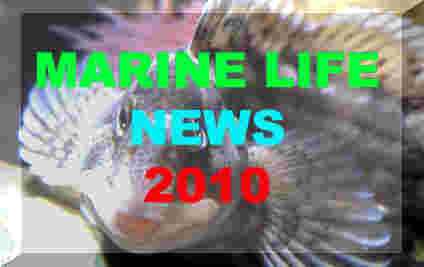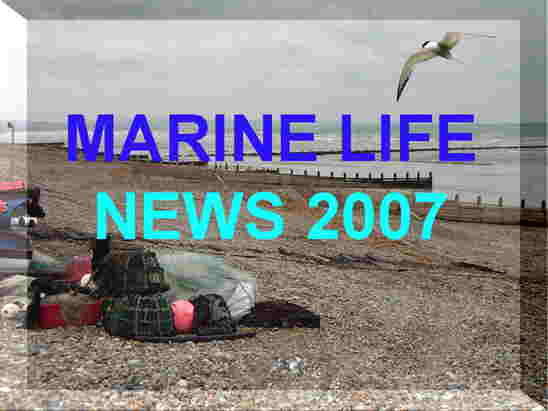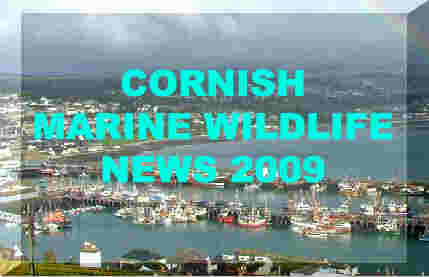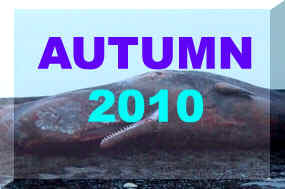EVENTS:

October
2010
Free
lectures: Seas for Life
‘Seas
for Life’: Our oceans, their future and their biodiversity
Birkbeck
Institute of Environment, University of London in conjunction with
the Ecology
and Conservation Studies Society.
Details
of the Lecture Programme (Link)
LATEST
NEWS:
Late
September 2010
The
alien (Mediterranean)
red seaweed
Feldmannophycus ocmuriae (or Caulacanthus
ustulatus) was discovered at Pen-y-Holt,
south Pembrokeshire. We have found it at West
Angle Bay and at South Hook Point.
BMLSS
Algae
21
September 2010
An
Arctic
Tern,
Sterna
paradisaea, was ringed as a chick
on the Farne
Islands on 28 June 1980,
making it at least 30 years, two months and 23 days old.
Summer
2010
Atlantic
Bonito,
Sarda
sarda, seem to be unusually a common
around the south-west of England with reports probable sightings of small
groups of small tuna by anglers and fishermen off
the South Cornwall coast from June onwards,
reports
of single fish being landed at Brixham and Newlyn, and two at Clovelly.

On
29
August 2010, the two fish in the photograph
were landed at Plymouth.
BMLSS
Scombridae
1 September
2010
An
earthquake
measuring 3.5 on the Richter
Scale was recorded in the North
Sea.
27
August 2010 >
Sunfish,
Mola
mola, Reports
(Link)
23
August 2010
A
colourful and scarce discovery of a Streaked
Gurnard,
Trigloporus
lastoviza,
was
captured on video
in Falmouth Bay,
south Cornwall.
Video
on Kennack
Diving (Facebook)
Kennack
Diving
This
is Cornwall Report

Streaked
Gurnard
Photograph
by Des Glover
The
Streaked
Gurnard
is
an unusual discovery in British seas, a rare fish north of the English
Channel and usually found at depths in excess
of 40 metres in warmer southerly waters including throughout the Mediterranean
Sea. It is easily mistaken for the Tub
Gurnard,
Chelidonichthys
lucerna, which
can also have a distinct blue fringe to its pectoral fins. The identity
of this fish has been confirmed by experts.
23
August 2010 >
Mackerel
(NE Atlantic) dispute on facebook
(BMLSS Page) (Notes and Links)
12
August 2010
A
two metre long Shadefish (a Drumfish),
Argyrosomus
regius, was netted off Portland
Bill, Dorset, and landed at Brixham,
Devon. This
migratory
Mediterranean* fish is a rare capture in British seas with only two previous
BMLSS records of complete fish in 1998
and 2008.
The book name Meagre
or Maigre was
a transcription mistake in an old book and I have discontinued its vernacular
use. The capture was of an adult fish weighing
25 kg. This large fish is identified by its
yellow
mouth. It preys on other fishes including
Grey
Mullet. (*It is also found off the Atlantic
coast of Portugal.)
BMLSS
Shadefish
31
July - 16 August 2010
An
adult Humpback Whale,
Megaptera
novaengliae, was washed ashore off
the coast at St
Ives, Cornwall. The heartbreaking addition to the story was a six metre
long juvenile Humpback Whale had
been seen at nearby Godrevy
(on the opposite side of St Ives Bay) attracted to a buoy as though it
was his mother. The baby whale slowly starved to death over a period of
two weeks.
8
August 2010
The
carcass of a baby cetacean
was washed up on the shore at South Heacham
Beach, (west facing shore of the Wash) Norfolk . It was about a metre long
and the skull about 23 cm. It is most likely to be a baby Harbour
Porpoise,
Phocoena phocoena.
Whales
& Dophins in British Seas (by Steve Savage)
7
August 2010
There
was a Minke Whale, Balaenoptera
acutorostrata, breaching off Porthgwarra,
(near Land's End) Cornwall, at around 4:00
pm. It was about 3 or 4 kilometres offshore,
but easily visible through binoculars. I have seen many Minke
Whales
over the years but never breaching like this one. It seemed to hang vertically
completely clear of the water then crash down with a huge splash. I even
lost count how many times it did this.
BMLSS
Cetacea
School
Holidays
Beware
of the Weever!
30
July 2010
The
now extremely rare Angel Shark (or
Monkfish), Squatina
squatina, was accidentally caught
off
Porthcawl (Wales)
in the Bristol Channel. It weighed 16.7 kg and its length was 123 cm including
the long tail. The shark was collected by the Natural
History Museum for research purposes.
In
2008,
the Angel Shark
received full legal protection from human activities in the waters off
England and Wales from the coast to a distance of 11 km (6.8 mi), under
the UK Wildlife and Countryside
Act. The United Kingdom and Belgium have pushed, unsuccessfully, for
this species to be listed on the Convention for the Protection of the Marine
Environment of the North-East Atlantic (OSPAR) Priority List of Threatened
and Endangered Species.
BMLSS
Sharks
17
July 2010
I
made a wonderful but sad discovery as I walked along the pebbles at Chesil
Cove, Dorset. At first, I could not take in what I was looking at because
it looked, somehow, so artificial – like a large model or toy. This exquisite
creature was a newly born (neonatal) Risso’s
Dolphin, Grampus
griseus.

The
stranded body of this small dolphin was about
1.3 metres long. It looked unlike any dolphin I had ever seen before and
was clearly not a Common
or Bottle-nose Dolphin
as it had no ‘beaked’ snout. The odd shape of the head is characteristic
of this species as also with the dorsal fin, pectoral fins and the tail
flukes.
Flung
ashore by huge waves, it was virtually unmarked but for a few grazes and
scratches on head and under-belly. The smooth, cold, rubbery skin shaded
from almost black, through grey and tan to near white; unblemished and
scarless with just a few fine lines and creases where the fins articulated
with the body and in the places most stretched – like the jaw line. Apparently
the broader barely perceptible marks along its sides are foetal folds and
the chief indicator that it had recently been born.
Full
Report & Images on Jessica’s
Nature Blog
BMLSS
Cetacea
BMLSS
Whales & Dolphins (by Steve Savage)
BMLSS
Strandlining
13
July 2010
The
MBA
Sepia (coastal research vessel) caught
a small Long-finned Gurnard, Chelidonichthys
obscurus,
in Bigbury Bay,
south Devon. This is only the second one recorded
in British seas.
The
Long-finned
Gurnard, Chelidonichthys
obscurus,is
found in shallow seas over sand with rocks to the south of British Isles
to Mauritania, west
Africa and throughout most of the Mediterranean Sea. This brown-bodied
fish has large black pectoral fins edged with bright blue. It will partially
bury itself in the soft sand when threatened. Its head is smaller than
most of the other members of fish in the same family Triglidae.
11
July 2010
A
Humpback Whale,
Megaptera novaengliae,
was spotted off Rathlin
Island, Northern Island.
10
July 2010
A
huge pod of well over a hundred Bottle-nosed Dolphins, Tursiops
truncatus, appeared in Ligwy
Bay, east Anglesey,
some of them somersaulting over six metres into the air. The pod stretched
for over a mile of sea.

British
Marine Life News 2010
Cornish
Marine Life Records 2009 (Ray Dennis Records)
BMLSS
Oil Disasters page

























